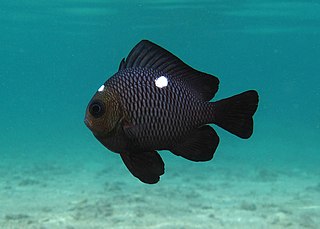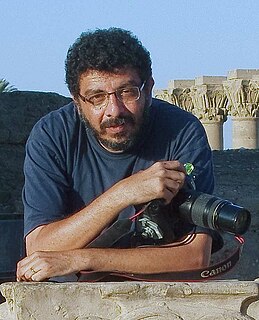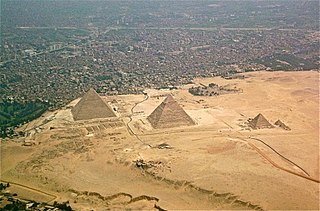
Johann LudwigBurckhardt was a Swiss traveller, geographer and Orientalist. Burckhardt assumed the alias Sheikh Ibrahim Ibn Abdallah during his travels in Arabia. He wrote his letters in French and signed Louis. He is best known for rediscovering the ruins of the ancient Nabataean city of Petra in Jordan.

Giovanni Battista Belzoni, sometimes known as The Great Belzoni, was a prolific Italian explorer and pioneer archaeologist of Egyptian antiquities. He is known for his removal to England of the seven-tonne bust of Ramesses II, the clearing of sand from the entrance of the great temple at Abu Simbel, the discovery and documentation of the tomb of Seti I, including the Sarcophagus of Seti I, and the first to penetrate into the Pyramid of Khafre, the second pyramid of the Giza complex.

The Fourth Dynasty of ancient Egypt is characterized as a "golden age" of the Old Kingdom of Egypt. Dynasty IV lasted from c. 2613 to 2494 BC. It was a time of peace and prosperity as well as one during which trade with other countries is documented.
Tomb KV21 is an ancient Egyptian tomb located in the Valley of the Kings in Egypt. It was discovered in 1817 by Giovanni Belzoni and later re-excavated by Donald P. Ryan in 1989. It contains the mummies of two women, thought to be Eighteenth Dynasty queens. In 2010, a team headed by Zahi Hawass used DNA evidence to tentatively identify one mummy, KV21A, as the biological mother of the two fetuses preserved in the tomb of King Tutankhamun.

Faiyum is a city in Middle Egypt. Located 100 kilometres southwest of Cairo, in the Faiyum Oasis, it is the capital of the modern Faiyum Governorate. Originally called Shedet in Egyptian, the Greeks called it in Koinē Greek: Κροκοδειλόπολις, romanized: Krokodilópolis, and later Medieval Greek: Ἀρσινόη, romanized: Arsinoë. It is one of Egypt's oldest cities due to its strategic location.

The Sea Goldie, also known as the Orange Basslet, Lyretail Coralfish, Onestripe Goldie, Lyretail Anthias, Lyretail Fairy Basslet, Orange Fairy Basslet, Orange Seaperch, Scalefin Basslet, Scalefin Fairy Basslet and Scalefin Anthias, is a species of marine ray-finned fish, an anthias from the subfamily Anthiinae part of the family Serranidae, the groupers and sea basses. It has a wide Indo-Pacific distribution. It is found in the aquarium trade.

The masked puffer is a pufferfish in the family Tetraodontidae.

Parupeneus cyclostomus, the gold-saddle goatfish, blue goatfish or yellowsaddle goatfish, is a species of goatfish native to the Indo-Pacific. It is a commercially important species, as well as being sought out as a game fish, though it has been reported as carrying the ciguatera toxin. It can also be found in the aquarium trade.

The wildlife of Egypt is composed of the flora and fauna of this country in northeastern Africa and southwestern Asia, and is substantial and varied. Apart from the fertile Nile Valley, which bisects the country from south to north, the majority of Egypt's landscape is desert, with a few scattered oases. It has long coastlines on the Mediterranean Sea, the Gulf of Suez, the Gulf of Aqaba and the Red Sea. Each geographic region has a diversity of plants and animals each adapted to its own particular habitat.

The threespot dascyllus, also known as the domino damsel or simply domino, is a species of damselfish from the family Pomacentridae. It is native to the Indo-Pacific from the Red Sea and East Africa, to the Pitcairn Islands, southern Japan, and Australia, and can also be found in some parts of the Philippines. Its grey to black body has two lateral white spots and one between the eyes like domino hence the name; the threespot dascyllus grows up to 13 cm in length. Coloration is somewhat variable; the spot on the forehead may be absent and the lateral spots very much reduced. It feeds on algae, copepods and other planktonic crustaceans.

The bushy-tailed jird or bushy-tailed dipodil is a species of rodent in the family Muridae. It is the only species in the genus Sekeetamys. It is found in Egypt, Israel, Jordan, Saudi Arabia, and Sudan. Its natural habitat is rocky areas.

Prince Kamal el Dine Hussein was the son of Sultan Hussein Kamel of Egypt.

Sherif Sonbol is an Egyptian photographer specializing in architecture, scenic fine arts and photojournalism.

The Cave of the Beasts is a huge natural rock shelter in the Western Desert of Egypt featuring Neolithic rock paintings, more than 7,000 years old, with about 5,000 figures.
Ferial Qadin was a consort to Ismail Pasha, and mother to their son Fuad I of Egypt.

The Western Desert of Egypt is an area of the Sahara that lies west of the river Nile, up to the Libyan border, and south from the Mediterranean Sea to the border with Sudan. It is named in contrast to the Eastern Desert which extends east from the Nile to the Red Sea. The Western Desert is mostly rocky desert, though an area of sandy desert, known as the Great Sand Sea, lies to the west against the Libyan border. The desert covers an area of 680,650 km2 (262,800 sq mi) which is two-thirds of the land area of the country. Its highest elevation is 1,000 m (3,300 ft) in the Gilf Kebir plateau to the far south-west of the country, on the Egypt-Sudan-Libya border. The Western Desert is barren and uninhabited save for a chain of oases which extend in an arc from Siwa, in the north-west, to Kharga in the south. It has been the scene of conflict in modern times, particularly during the Second World War.
Gilf Kebir National Park (GKNP) is a national park located in the remote and hyper-arid New Valley Governorate, Egypt. Established in 2007, it has a surface area of 48533 km2, equal to about 5% of Egypt's territory. GKNP is delimited to the west by Libya and to the south by Sudan. At present there are no human settlements or facilities inside the GKNP.
Road to Eilat is an Egyptian war film released in 1993. It is directed by Inaam Mohammed Ali and features Salah Zulfikar in a special appearance as Admiral Fouad Abu Zikry the commander of Egyptian Navy. The films stars Ezzat El Alaili and Nabil Al-Halfawi. Road to Eilat is Salah Zulfikar’s final film.














